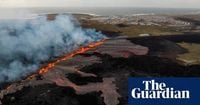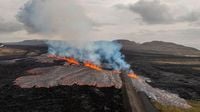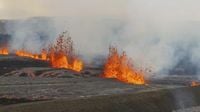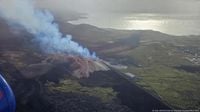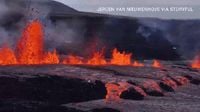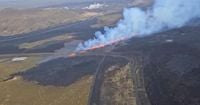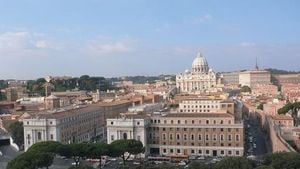A volcano began erupting in southwestern Iceland on April 1, 2025, just hours after authorities evacuated the nearby town of Grindavik and the popular Blue Lagoon spa. Flames and smoke shot through the air as the volcanic fissure opened near Grindavik, where around 40 homes were evacuated, according to the national broadcaster RUV.
The eruption, which started at 9:45 a.m. local time (0945 GMT), was preceded by a series of small earthquakes, including a significant tremor with a magnitude of 5.2. This seismic activity indicated that an eruption was imminent, prompting the police and civil defense officials to act swiftly.
Grindavik, located on the Reykjanes Peninsula, was largely evacuated in November 2023 when the volcano first came to life after being dormant for 800 years. On April 1, 2025, the Icelandic Meteorological Office (IMO) reported that two fissures had opened near the town, one of which had breached a protective barrier, forcing residents to evacuate as lava became dangerously close to the community.
“Warning: An eruption has begun,” stated the Icelandic Meteorological Office in a public alert. The fissures, one stretching nearly 1.2 kilometers, began spewing lava and volcanic gases, creating a dire situation for the town. By noon, officials had declared the town empty of civilians, although some residents initially resisted the evacuation order.
“Those individuals who choose to remain in the town don’t seem to consider that I have 50 people involved in this operation, some of whom are volunteers,” said Úlfar Lúðvíksson, the police commissioner in South Iceland. He urged those who remained to reconsider their decision in light of the potential danger.
The Blue Lagoon, one of Iceland’s biggest tourist attractions, was also evacuated. Guests were moved to nearby hotels as the eruption began. The spa announced that it would remain closed until further notice, with plans to assess the situation later.
“Emergency responders in Grindavík have reported that earthquakes can be felt in the town, and signs of deformation are also visible there, suggesting that fault movements could occur within the town itself,” the IMO noted, indicating the severity of the geological activity in the area.
Runólfur Þórhallsson, Iceland’s director of civil protection, emphasized that this eruption could be larger than previous ones. “The magma tunnel is longer, and a lot of magma has accumulated,” he explained. This eruption marks the 11th event in the region since 2021, when the Reykjanes Peninsula entered a new period of volcanic activity.
Despite the alarming situation, flights remained unaffected by the eruption, and the Keflavík International Airport continued to operate normally. However, authorities warned that gas from the eruption could travel northeast toward Reykjavík, depending on wind conditions.
The Reykjanes Peninsula had been dormant for centuries, and the recent surge in volcanic activity has raised concerns among residents and officials alike. The geological instability has led to repeated evacuations, with most of Grindavik’s 4,000 residents having left the town during the last major evacuation in 2023.
Local media reported that the fissures opened just north of Grindavik’s protective barriers, with one fissure growing to about 700 meters by mid-morning. The IMO indicated that the fissure could continue to open further south, posing an ongoing threat to the town.
As the situation develops, local authorities have closed roads in and out of the area and issued a 'red alert' for Grindavik. Travelers have been advised to respect the closures and instructions from local authorities, emphasizing the need for safety amid the ongoing volcanic activity.
“The eruption is still developing, and we will publish further information when gathered,” said Snorri Valsson, a spokesperson for the Icelandic tourist board. Although the immediate effects have been localized, the potential for future eruptions remains a concern as experts continue to monitor the seismic activity in the region.
Iceland, known as the land of ice and fire, sits above a volcanic hotspot in the North Atlantic. The most disruptive incident in recent history was the 2010 eruption of the Eyjafjallajökull volcano, which caused widespread disruption to air travel. Fortunately, this recent eruption is not expected to have similar effects on air traffic, although the situation remains fluid and subject to change.
As authorities continue to assess the situation, residents and tourists alike are left to grapple with the reality of living in a region marked by such intense geological activity. The community of Grindavik, once a bustling fishing village, now faces an uncertain future as it navigates the challenges posed by the ongoing threat of volcanic eruptions.
